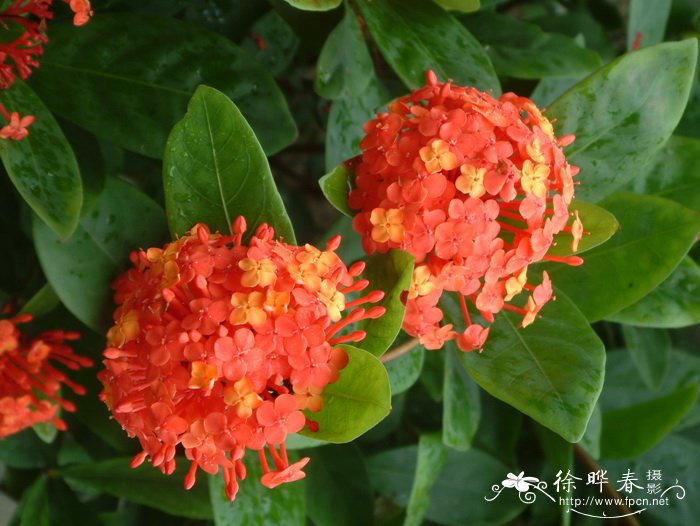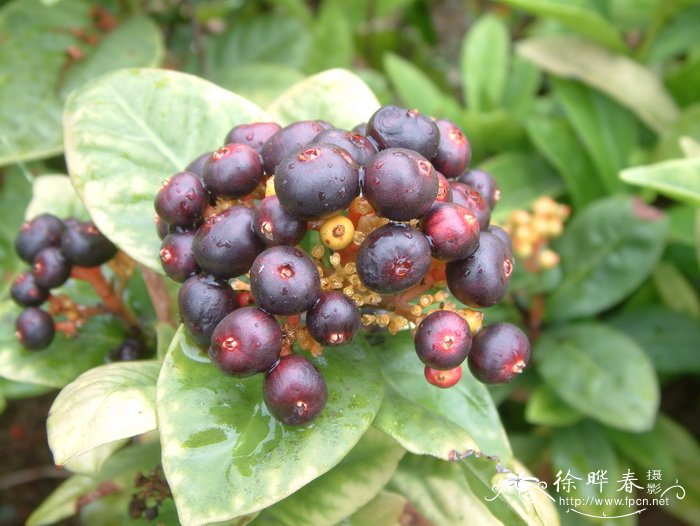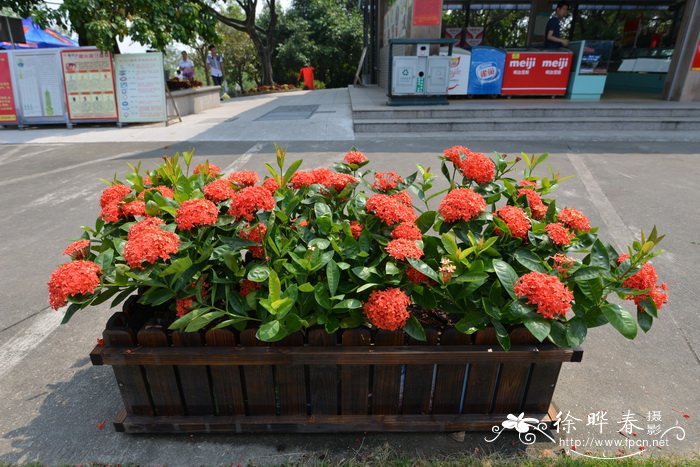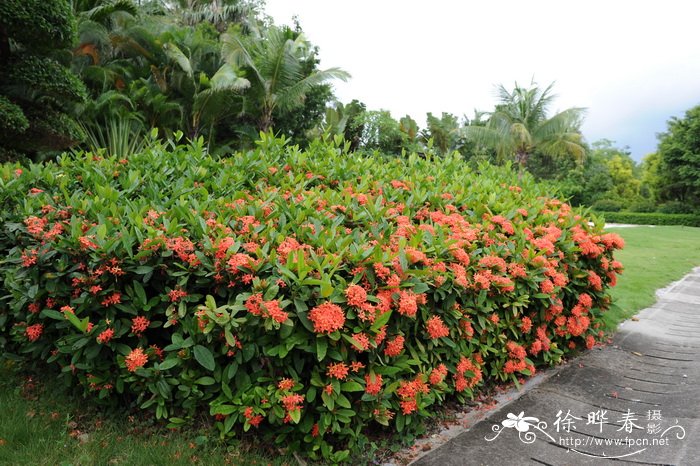龙船花Ixora chinensis
中文名(Chinese Name):龙船花
学名(Scientific Name):Ixora chinensis Lam.
英文名(English Common Name):
别名(Chinese Common Name):山丹
异名(Synonym):Pavetta kroneana Miq. Ixora crocata Lindl. Ixora strica Roxb. Ixora strica var. incarnata Benth. Bemsetia paniculata Raf. Pavetta chinensis (Lam.) Roem. & Schult. Ixora speciosa Willd. Ixora pallida Reinw. ex Miq. Pavetta arborea Blanco Ixora kroneana (Miq.) Bremek. Ixora colei Gentil Ixora dixiana Gentil Ixora flammea Salisb. Ixora dubia Schult. Ixora blanda Ker Gawl. Pavetta stricta (Roxb.) Blume Ixora stricta Roxb. Ixora stricta var. mekongensis Pierre ex Pit.
科属(Family & Genus):茜草科(Rubiaceae)龙船花属
形态特征(Description):灌木,高0.8-2米,无毛;小枝初时深褐色,有光泽,老时呈灰色,具线条。叶对生,有时由于节间距离极短几成4枚轮生,披针形、长圆状披针形至长圆状倒披针形,长6-13厘米,宽3-4厘米,顶端钝或圆形,基部短尖或圆形;中脉在上面扁平成略凹入,在下面凸起,侧脉每边7-8条,纤细,明显,近叶缘处彼此连结,横脉松散,明显;叶柄极短而粗或无;托叶长5-7毫米,基部阔,合生成鞘形,顶端长渐尖,渐尖部分成锥形,比鞘长。花序顶生,多花,具短总花梗;总花梗长5-15毫米,与分枝均呈红色,罕有被粉状柔毛,基部常有小型叶2枚承托;苞片和小苞片微小,生于花托基部的成对;花有花梗或无;萼管长1.5-2毫米,萼檐4裂,裂片极短,长0.8毫米,短尖或钝;花冠红色或红黄色,盛开时长2.5-3厘米,顶部4裂,裂片倒卵形或近圆形,扩展或外反,长5-7毫米,宽4-5毫米,顶端钝或圆形;花丝极短,花药长圆形,长约2毫米,基部2裂;花柱短伸出冠管外,柱头2,初时靠合,盛开时叉开,略下弯。果近球形,双生,中间有1沟,成熟时红黑色;种子长、宽4-4.5毫米,上面凸,下面凹。花期5-7月。
分布(Distribution):产福建、广东、香港、广西,生于海拔200-800米山地灌丛中和疏林下,有时村落附近的山坡和旷野路旁亦有生长。越南、菲律宾、马来西亚、印度尼西亚等热带地区也有。
用途(Use):
引自中国植物志英文版:FOC Vol. 19 Page 177, 178, 179
Ixora chinensis Lamarck, Encycl. 3: 344. 1789.
龙船花 long chuan hua| Rubiaceae | Ixora
Gaertnera hongkongensis Seemann; Ixora crocata Lindley; I. stricta Roxburgh; I. stricta var. incarnata Bentham; Pavetta kroneana Miquel; Sykesia hongkongensis (Seemann) Kuntze; Tsiangia hongkongensis (Seemann) But, H. H. Hsue & P. T. Li.
Shrubs, 0.8-2 m tall; branches glabrous. Leaves opposite, sometimes apparently in whorls of 4 due to reduced stem internodes, sessile or petiolate; petiole to 5 mm, glabrous; blade drying leathery, oblanceolate, oblong-oblanceolate, obovate, elliptic-oblong, or lanceolate, 6-18 × 3-6 cm, glabrous on both surfaces, base cuneate to shortly truncate or rounded, apex obtuse or rounded to acute; secondary veins 7-9 pairs; stipules persistent, united around stem to almost interpetiolar, triangular to broadly triangular, 3-7 mm, glabrous to glabrescent, costate, acute and with arista 2-10 mm. Inflorescence terminal, congested-cymose to congested-corymbiform, many flowered, puberulent to hirtellous, subsessile to pedunculate; peduncle to 1.5 cm, often subtended by 2 reduced leaves or leaflike bracts; branched portion 1-4 × 1-5 cm (not including corollas); bracts triangular, 0.2-1 mm; pedicels to 2 mm. Flowers subsessile to pedicellate. Calyx glabrous; hypanthium obconic to ovoid, 1-1.5 mm; limb deeply lobed; lobes triangular to ligulate, 0.5-1 mm, acute or obtuse. Corolla red or reddish yellow, outside glabrous; tube 20-30 mm, glabrous in throat; lobes ovate, elliptic, or broadly elliptic, 5-7 × 4-5 mm, broadly obtuse to rounded. Drupe reddish black, subglobose and shallowly didymous, 6-7 × 6-7 mm, glabrous. Fl. May-Jul and Dec, fr. Sep-Oct.
Thickets, sparse forests; 200-800 m. Fujian, Guangdong, Guangxi [Indonesia, Malaysia, Philippines, Vietnam; widely cultivated in tropical regions].
This is a commonly collected species of Ixora in China, apparently growing naturally as well as in cultivation. The occasional short stem internodes, which sometimes produce congested groups of leaves, appear to possibly be due to a change in growth pattern at the top of a seasonal spurt that includes several internodes. The circumscription and characters of this species were considered in some detail by Fosberg and Sachet (Baileya 23(2): 77. 1989), who noted that it is sometimes cultivated. Bridson (Kew Bull. 55: 1011-1012. 2000) studied the identity of Tsiangia, and formally synonymized its only species, T. hongkongensis, with I. chinensis.




(责任编辑:徐晔春)
学名(Scientific Name):Ixora chinensis Lam.
英文名(English Common Name):
别名(Chinese Common Name):山丹
异名(Synonym):Pavetta kroneana Miq. Ixora crocata Lindl. Ixora strica Roxb. Ixora strica var. incarnata Benth. Bemsetia paniculata Raf. Pavetta chinensis (Lam.) Roem. & Schult. Ixora speciosa Willd. Ixora pallida Reinw. ex Miq. Pavetta arborea Blanco Ixora kroneana (Miq.) Bremek. Ixora colei Gentil Ixora dixiana Gentil Ixora flammea Salisb. Ixora dubia Schult. Ixora blanda Ker Gawl. Pavetta stricta (Roxb.) Blume Ixora stricta Roxb. Ixora stricta var. mekongensis Pierre ex Pit.
科属(Family & Genus):茜草科(Rubiaceae)龙船花属
形态特征(Description):灌木,高0.8-2米,无毛;小枝初时深褐色,有光泽,老时呈灰色,具线条。叶对生,有时由于节间距离极短几成4枚轮生,披针形、长圆状披针形至长圆状倒披针形,长6-13厘米,宽3-4厘米,顶端钝或圆形,基部短尖或圆形;中脉在上面扁平成略凹入,在下面凸起,侧脉每边7-8条,纤细,明显,近叶缘处彼此连结,横脉松散,明显;叶柄极短而粗或无;托叶长5-7毫米,基部阔,合生成鞘形,顶端长渐尖,渐尖部分成锥形,比鞘长。花序顶生,多花,具短总花梗;总花梗长5-15毫米,与分枝均呈红色,罕有被粉状柔毛,基部常有小型叶2枚承托;苞片和小苞片微小,生于花托基部的成对;花有花梗或无;萼管长1.5-2毫米,萼檐4裂,裂片极短,长0.8毫米,短尖或钝;花冠红色或红黄色,盛开时长2.5-3厘米,顶部4裂,裂片倒卵形或近圆形,扩展或外反,长5-7毫米,宽4-5毫米,顶端钝或圆形;花丝极短,花药长圆形,长约2毫米,基部2裂;花柱短伸出冠管外,柱头2,初时靠合,盛开时叉开,略下弯。果近球形,双生,中间有1沟,成熟时红黑色;种子长、宽4-4.5毫米,上面凸,下面凹。花期5-7月。
分布(Distribution):产福建、广东、香港、广西,生于海拔200-800米山地灌丛中和疏林下,有时村落附近的山坡和旷野路旁亦有生长。越南、菲律宾、马来西亚、印度尼西亚等热带地区也有。
用途(Use):
引自中国植物志英文版:FOC Vol. 19 Page 177, 178, 179
Ixora chinensis Lamarck, Encycl. 3: 344. 1789.
龙船花 long chuan hua| Rubiaceae | Ixora
Gaertnera hongkongensis Seemann; Ixora crocata Lindley; I. stricta Roxburgh; I. stricta var. incarnata Bentham; Pavetta kroneana Miquel; Sykesia hongkongensis (Seemann) Kuntze; Tsiangia hongkongensis (Seemann) But, H. H. Hsue & P. T. Li.
Shrubs, 0.8-2 m tall; branches glabrous. Leaves opposite, sometimes apparently in whorls of 4 due to reduced stem internodes, sessile or petiolate; petiole to 5 mm, glabrous; blade drying leathery, oblanceolate, oblong-oblanceolate, obovate, elliptic-oblong, or lanceolate, 6-18 × 3-6 cm, glabrous on both surfaces, base cuneate to shortly truncate or rounded, apex obtuse or rounded to acute; secondary veins 7-9 pairs; stipules persistent, united around stem to almost interpetiolar, triangular to broadly triangular, 3-7 mm, glabrous to glabrescent, costate, acute and with arista 2-10 mm. Inflorescence terminal, congested-cymose to congested-corymbiform, many flowered, puberulent to hirtellous, subsessile to pedunculate; peduncle to 1.5 cm, often subtended by 2 reduced leaves or leaflike bracts; branched portion 1-4 × 1-5 cm (not including corollas); bracts triangular, 0.2-1 mm; pedicels to 2 mm. Flowers subsessile to pedicellate. Calyx glabrous; hypanthium obconic to ovoid, 1-1.5 mm; limb deeply lobed; lobes triangular to ligulate, 0.5-1 mm, acute or obtuse. Corolla red or reddish yellow, outside glabrous; tube 20-30 mm, glabrous in throat; lobes ovate, elliptic, or broadly elliptic, 5-7 × 4-5 mm, broadly obtuse to rounded. Drupe reddish black, subglobose and shallowly didymous, 6-7 × 6-7 mm, glabrous. Fl. May-Jul and Dec, fr. Sep-Oct.
Thickets, sparse forests; 200-800 m. Fujian, Guangdong, Guangxi [Indonesia, Malaysia, Philippines, Vietnam; widely cultivated in tropical regions].
This is a commonly collected species of Ixora in China, apparently growing naturally as well as in cultivation. The occasional short stem internodes, which sometimes produce congested groups of leaves, appear to possibly be due to a change in growth pattern at the top of a seasonal spurt that includes several internodes. The circumscription and characters of this species were considered in some detail by Fosberg and Sachet (Baileya 23(2): 77. 1989), who noted that it is sometimes cultivated. Bridson (Kew Bull. 55: 1011-1012. 2000) studied the identity of Tsiangia, and formally synonymized its only species, T. hongkongensis, with I. chinensis.
(责任编辑:徐晔春)
踩一下[5]

顶一下[14]